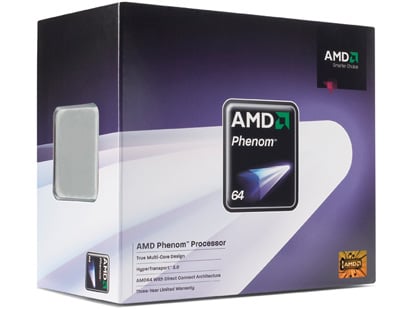
A few days ago, AMD officially unveiled their RV670 GPU, the chip at the heart of the ATI Radeon HD 3800 series of graphics cards. Just in case you missed it on the day of the launch, our coverage of the new Radeon HD 3870 and HD 3850 cards is available right here. While we did thoroughly explain the RV670鈥檚 architecture and explored its performance in that article, we did not tell you that the new Radeon HD 3800 series is but one part of an entirely new platform from AMD dubbed 鈥淪pider鈥?
The rest of the Spider platform is comprised of not only new desktop processors, but core logic as well. The second piece to the Spider puzzle is AMD鈥檚 native quad-core Phenom processor and the third is the new 7-series chipset.
News of Phenom and the 7-series chipset has been circulating for what seems like an eternity. We鈥檝e shown you glimpses of the platform and talked about its new features in a number of articles and news posts here at HotHardware. But today we can finally give you all of the details and show you just how AMD鈥檚 new processors and chipsets perform.
Before we get started, some specifications are in order. What we have for you in the table below are the main specifications and features of the AMD Phenom 9600 and 9500 processors. Take a gander at the specifics and then strap yourself in as we take a hands-on look at AMD鈥檚 latest and greatest and even check out the Phenom 9700, which won鈥檛 be available until early next year.

AMD Phenom Retail Box

| | AMD Phenom Processors | | Specifications and Features |
|
| Model / Processor Frequency: | AMD Phenom Processor Model 9600 / 2.3GHz |
| Model / Processor Frequency: | AMD Phenom Processor Model 9500 / 2.2GHz |
| L1 Cache Sizes: | 64K of L1 instruction and 64K of L1 data cache per core (512KB total L1 per processor) |
| L2 Cache Sizes: | 512KB of L2 data cache per core (2MB total L2 per processor) |
| L3 Cache Size: | 2MB |
| Memory Controller Type: | Integrated 128-bit wide memory controller, capable of being configured for dual 64-bit channels for simultaneous read/writes |
| Memory Controller Frequency: | Up to 1.8GHz with Dual Dynamic Power Management |
| Types of Memory: | Support for unregistered DIMMs up to PC2 8500 (DDR2-1066MHz) |
| HyperTransport 3.0: | One 16-bit/16-bit link @ up to 3600MHz full duplex |
| Total Processor Bandwidth: | Up to 31.5 GB/s bandwidth |
| Packaging: | Socket AM2+ 940-pin organic micro pin grid array (micro-PGA) (backward compatible with Socket AM2) |
| Fab location: | AMD's Fab 36 wafer fabrication facilities in Dresden, Germany |
| Process Technology: | 65nm (.065-micron) Silicon on Insulator (SOI) |
| Approximate Transistor count: | approx. 450 million (65nm) |
| Approximate Die Size: | 285 mm2 (65nm) |
| Nominal Voltage: | 1.1-1.25 Volts |
| Max Ambient Case Temp: | 70 degrees Celsius |
| Max TDP: | 95 Watts |
| ACP: | *to be announced after launch |
| Future Memory Controller Note: | Future 45nm processors versions are planned to include support for DDR3 memory |
We have posted a wealth of information regarding AMD's processors and related core-logic chipsets over the last few months here at HotHardware.com. For some more background on the technologies employed by AMD's processors and platforms as a whole, we suggest taking a look at few of the related articles listed below. They contain detailed explanations of some of the features common to AMD's legacy products, compatible chipsets, and the enhancements make to various products over their lifetime:
- ATI Radeon HD 3870 and 3850: 55nm RV670
- AMD Barcelona Architecture Launch: Native Quad-Core
- AMD Quad-FX Platform and FX-70 Series Processors
- AMD Socket AM2 Athlon 64 FX-62 and 5000+ Evaluation
- AMD Athlon 64 X2 Energy Efficient Processor Evaluation
We cover some specifics regarding AMD's current dual-core socket AM2 processor offerings in our FX-62 and 5000+ evaluation, and cover all of the details regarding the Quad-FX platform and the FX-70 series processors in that launch article. The AMD Barcelona Architecture Launch: Native Quad-Core article is perhaps the most relevant, as we cover AMD's native quad-core architecture there, which is the basis of the Phenom processor we'll show you on the next page. And then of course, there is our coverage of the new Radeon HD 3870 and HD 3850 cards, which are an integral part of the AMD Spider Platform.

